I thought it might be fun to share the steps involved in creating and finishing my jewelry . . . especially since I'm awaiting an order for sterling wire and I have people w.a.i.t.i.n.g. for their orders - YIKES!! So if you're wondering why your order might take a little while to arrive, here's a look at the process your piece goes through before you receive it.
 |
| This is my view while I'm creating. I keep my paid orders posted where I can see them, so I can plan my strategy for each work session. Because so much of my work requires multiple steps, it's more efficient to lump similar jobs together. |
|
|
When I take an order, I record it on an index card with all the pertinent information: piece ordered, type of metal, size, length, stones etc. When I'm ready to sit down at my bench, I organize the cards by like jobs. I've learned that I can get a lot more accomplished if I break the process into chunks of similar steps. There are four processes that I use fairly regularly: fabricating, tumbling/buffing, adding patina, and sealing metal.
Fabricating is simply making the piece by hand. It might be a wire name ring, a charm holder pendant, ring or handmade chain with charms. Pretty much everything I create starts with wire of some kind, which gets bent, twisted, hammered, and/or soldered to make whatever piece I'm working on. I do use some ready made chains and findings, but for the most part I like to make everything by hand. The vast majority of the wire I use is what's known as dead soft or annealed, meaning it's very pliable and easy to bend. As the metal is worked it hardens, but not enough to securely hold its form when worn. Which brings me to my second process . . . tumbling.
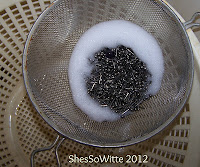

I use a Lortone 3A 3lb tumbler with about 1lb of stainless steel jewelry shot mix. I add the completed pieces and let them tumble for 2 hours to work harden and burnish. It doesn't take much to reach the 3 lb maximum weight limit which includes the weight of the drum, the shot and the jewelry to be tumbled. I'm seriously considering upgrading to a larger capacity model, but that's still in the research phase. Needless to say since it takes two hours to tumble, you really want to get several pieces ready before you run a batch or you'll find yourself up way past midnight! I've also discovered that it's best to set a timer when I turn it on so I get the full two hours and no more. And no, it's not a good idea to run to the store and leave it on *ahem* *whistling*
Once the pieces come out of the tumbler, I give them a good wash with Dawn and a soft bristle toothbrush, looking them over carefully to check for tool marks or dull spots. If it's sterling or it doesn't get a patina added, it goes straight to the polishing table where I use my electric Dremel with a 520 wheel to polish. If it's copper or a piece that needs oxidation, then it goes into the patina jar.
 |
| Original finish (left), dipped once (middle), raw copper (right) |
Patina and oxidation are fancy words for tarnish. Yep, patina is purposely tarnishing the metal to give it depth and character. It brings out the texture of hammered pieces and accents wire work beautifully. I use
Midas Liver of Sulfur from Rio Grande. It's simple and produces reliable results. I use distilled water since we have a well and our water is very hard. A tiny piece about the size of my pinky nail in 4 to 6 oz of water does the trick. The warmer the water or the piece, the faster and darker the patina forms. The customer who purchased the bracelet in the above photo needed a different style clasp, so I customized it for a perfect fit. It needed patina to match the original bracelet, so I made up some LOS.
Did I mention that Liver of Sulfur smells like rotten eggs?? Yeah . . . you want to have
some good ventilation or at a minimum have a dog or a husband around to
blame it on.
So once the metal is oxidized to the desired level, it's time for another cleaning with Dawn and onto sealing. Raw copper and brass oxidize rapidly and produce a green residue on the skin if not sealed - aluminum and phosphor bronze will turn the skin black - so yeah, you want that sealed. Another advantage to sealing the metal is that the patina stays consistent over time even in humid conditions and with frequent wear.

I use
Everbrite ProtectaClear to seal all my non-sterling metal, as well as sterling that has been oxidized. It might seem a bit pricey, but believe me a little goes a long way and it's worth its weight in gold for making pesky metals behave themselves! The trick to this stuff is preparation. The piece needs to be immaculately clean and completely free of oils or residue from buffing . . . thus the numerous washings with Dawn. Once the piece is clean and dry, I use Xylene/Xylol (which smells like Magic Marker in a can) to remove any remnants of oil or buffing compound that I might have missed. Once it dries I use a combination of dipping and brushing off the excess with a natural bristle brush. The manufacturer recommends 2-3 coats for most items, waiting approximately 30 minutes between applications. I use the oven method (180°F for at least one hour) to cure it quickly, otherwise it requires 4-5 days to cure . . . and I don't have that long!
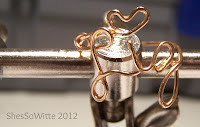
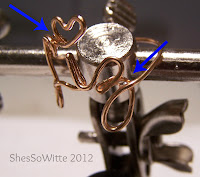
ProtectaClear is a great product, but it definitely takes some getting used to. I've used the liquid and the aerosol, but I much prefer the liquid and I find that now I almost always dip, then remove the excess with the brush. If you're doing something with lots of links or wire wrapping, it's important to check for pooling (see photo left). While ProtectaClear is self-leveling, excessive application will still produce a run or stuck links.
Shaking the chain at every stage including fresh out of the oven is crucial for good coverage with free movement of the parts. I hang my pieces with the areas of heaviest potential use pointing downward for heavier coverage and theoretically better protection. So far I've been well pleased, and have had no complaints about skin discoloration. Once it comes out of the oven, the piece gets one more inspection to
make sure everything looks right and then it's ready for photos. Bet you didn't realize how involved it was, huh??
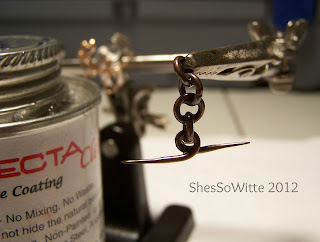 |
| Custom clasp with ProtectaClear drying between coats. |
|
 |
| Agate bead rosary chain bracelets in brass and phosphor bronze. |
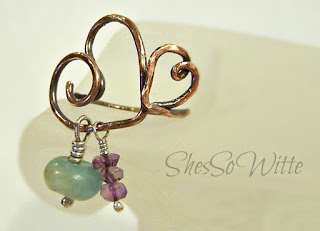 To the left is a photo of a piece I created as a result of this special request. The only reason I was able to create this ring is because I have the technique of how to solder two kinds of metal together in my bag of tricks. Notice that despite the two different colors of metal (copper and phosphor bronze), the piece appears to be all the same color.
To the left is a photo of a piece I created as a result of this special request. The only reason I was able to create this ring is because I have the technique of how to solder two kinds of metal together in my bag of tricks. Notice that despite the two different colors of metal (copper and phosphor bronze), the piece appears to be all the same color. 














+-+Copy.jpg)

